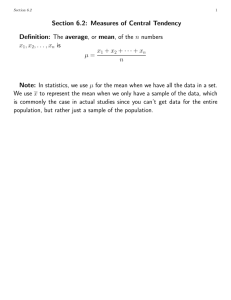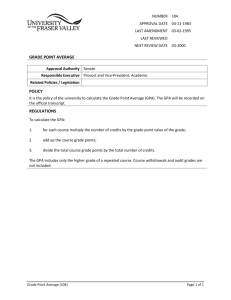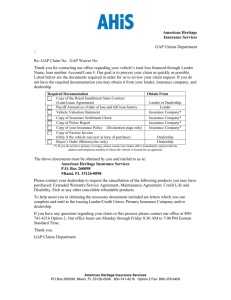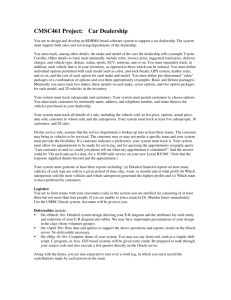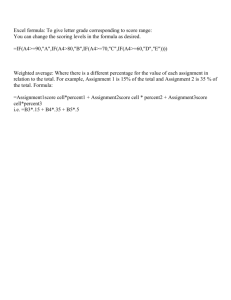Lab is due Monday, April 16 th . Turn in your handout and email me
advertisement
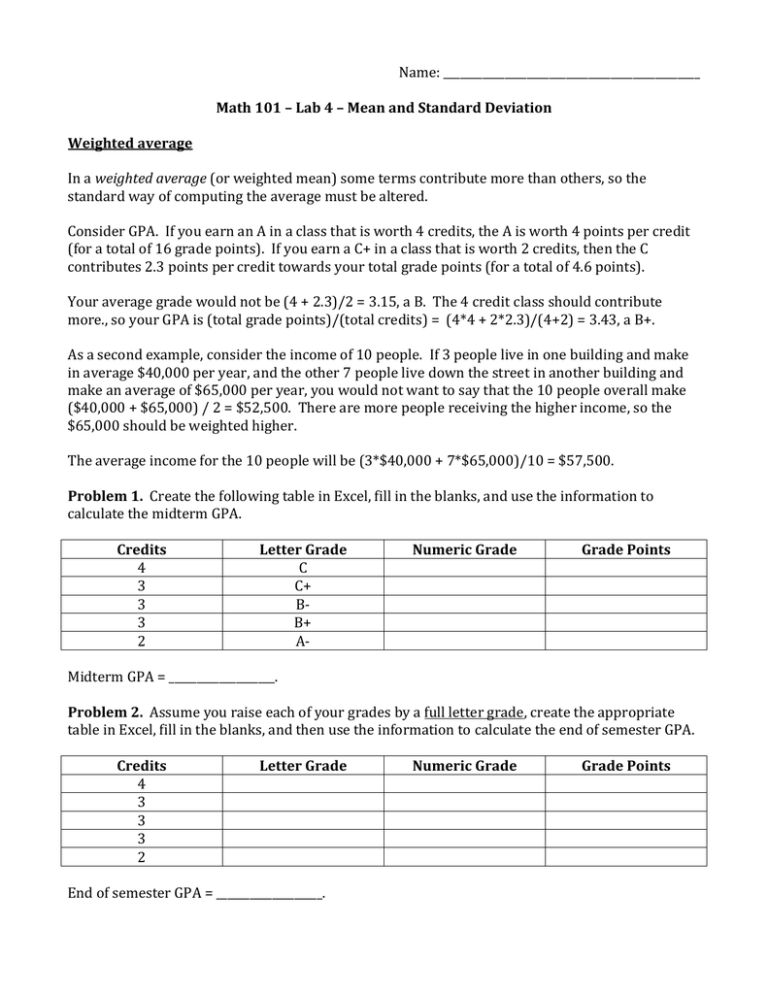
Name: ______________________________________________ Math 101 – Lab 4 – Mean and Standard Deviation Weighted average In a weighted average (or weighted mean) some terms contribute more than others, so the standard way of computing the average must be altered. Consider GPA. If you earn an A in a class that is worth 4 credits, the A is worth 4 points per credit (for a total of 16 grade points). If you earn a C+ in a class that is worth 2 credits, then the C contributes 2.3 points per credit towards your total grade points (for a total of 4.6 points). Your average grade would not be (4 + 2.3)/2 = 3.15, a B. The 4 credit class should contribute more., so your GPA is (total grade points)/(total credits) = (4*4 + 2*2.3)/(4+2) = 3.43, a B+. As a second example, consider the income of 10 people. If 3 people live in one building and make in average $40,000 per year, and the other 7 people live down the street in another building and make an average of $65,000 per year, you would not want to say that the 10 people overall make ($40,000 + $65,000) / 2 = $52,500. There are more people receiving the higher income, so the $65,000 should be weighted higher. The average income for the 10 people will be (3*$40,000 + 7*$65,000)/10 = $57,500. Problem 1. Create the following table in Excel, fill in the blanks, and use the information to calculate the midterm GPA. Credits 4 3 3 3 2 Letter Grade C C+ BB+ A- Numeric Grade Grade Points Midterm GPA = ___________________. Problem 2. Assume you raise each of your grades by a full letter grade, create the appropriate table in Excel, fill in the blanks, and then use the information to calculate the end of semester GPA. Credits 4 3 3 3 2 Letter Grade End of semester GPA = ___________________. Numeric Grade Grade Points Problem 3. Create the table below in Excel, fill in the blanks, and use it to determine the overall GPA. Semester 1 2 3 4 Total Credits 18 15 17 17 GPA 3.8 2.7 3.2 3.3 Total Grade Points Cumulative GPA = ________________________. Create a line chart showing the GPA over time. Standard Deviation Consider the following data about the number of sales per week at two different dealerships: Weekly sales 4 5 6 7 8 9 10 Number of occurrences (frequency) Dealership A Dealership B 2 15 3 0 9 1 20 12 14 15 3 48 1 13 Problem 4. Enter the data for Dealership A and Dealership B into Excel (create 2 different tables, Dealership A first and then Dealership B below it). Next to the frequency for each dealership, use Excel to find the relative frequency (add this to you table): 1 2 3 4 5 A Dealership A Weekly Sales 4 5 … B C Frequency 2 3 … Rel. Freq ?? ?? … Create a chart in Excel of the relative frequencies for each dealership. Problem 5. For each dealership, find the mean number of weekly sales. Be careful, you have to take a weighted mean (just like for the GPA calculations). For example, for Dealership A, 4 sales in one week happens twice, 5 sales in one week happens 3 times, etc. If you were buying a car dealership based on which one sells more cars per week on average, which one would you pick? Computing the standard deviation. Recall that the distribution of a data set describes the values taken on and their frequencies. To describe the distribution we have statistical variables such as range (max value – min value), mean (average), median (middle point of values), and mode. It is also possible to discuss how the distribution is skewed (left or right or not at all). Variation describes how spread out the data is from the center. One way to measure and display variation is with the 5-number summary and the accompanying box plot. The five numbers in the 5-number summary split the collection of values into quarters. Another way to describe variation is with the standard deviation. It’s a measure of how far your data points are from the mean. The larger the standard deviation, the more spread out. Standard deviation = sum of (data value mean) 2 number data values 1 To compute this: 1. 2. 3. 4. 5. Find the mean of your data set. For each data point, take (data point – mean)2. Add this up for every data point. Divide by the number of data points -1. Take the square root of this. Problem 6. For the following data points, find the mean and compute the standard deviation: 1, 2, 3, 6, 7, 9 Here’s how to set it up in Excel: A B 1 Data Points Points - mean 2 1 =(A2 – mean) 3 2 etc. 4 3 5 6 6 7 7 9 8 Compute the mean here C Squared =B2^2 etc. D E Sum up the squared terms Take the square root of the sum divided by (6 – 1) this is the standard deviation Problem 7. Do the same thing and find the standard deviation for the following data: 2, 3, 4, 4, 5, 5 Which of the two data sets is more spread out? Note: There are built in functions in Excel to fid the mean and standard deviation: average() and stdev(). Try using them and check that you get the same result as above. Problem 8. Now using Excel, find the standard deviation for the weekly sales data for each dealership. You can use the following table to do this calculation: 1 A B Dealership A 2 Weekly Sales 3 4 4 5 5 6 7 8 9 10 6 7 8 9 10 11 Freq 2 3 9 20 14 3 1 C D Sales x Freq. Data value – mean =A3*B3 =A3 – C12 E F Previous column squared =(D3)^2 Multiply by number of data points =E3 * B3 G Total number of weeks Sum (sales x freq) Sum up above Mean =C10/B10 Standard Deviation 12 13 =sqrt(F11/(B11-1)) Which dealership shows greater variation in their number of weekly sales? Which dealership is more consistent in their sales? Lab is due Monday, April 16th. Turn in your handout and email me your Excel file: cthatcher@simons-rock.edu
